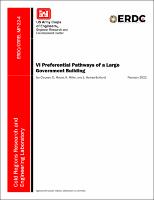Please use this identifier to cite or link to this item:
https://hdl.handle.net/11681/43260Full metadata record
| DC Field | Value | Language |
|---|---|---|
| dc.contributor.author | Clausen, Jay L. | - |
| dc.contributor.author | Moore, D. | - |
| dc.contributor.author | Miller, K. | - |
| dc.contributor.author | Haines-Ecklund, L. | - |
| dc.creator | Cold Regions Research and Engineering Laboratory (U.S.) | - |
| dc.date.accessioned | 2022-02-11T15:35:20Z | - |
| dc.date.available | 2022-02-11T15:35:20Z | - |
| dc.date.issued | 2022-02 | - |
| dc.identifier.govdoc | ERDC/CRREL MP-22-4 | - |
| dc.identifier.uri | https://hdl.handle.net/11681/43260 | - |
| dc.identifier.uri | http://dx.doi.org/10.21079/11681/43260 | - |
| dc.description | Miscellaneous Paper | en_US |
| dc.description.abstract | Trichloroethylene (TCE) releases from leaks and spills next to a large government building occurred over several decades with the most recent event occurring 20 years ago. In response to a perceived conventional vapor intrusion (VI) issue a sub-slab depressurization system (SSDS) was installed 6 years ago. The SSDS is operating within design limits and has achieved building TCE vapor concentration reductions. However, subsequent periodic TCE vapor spikes based on daily HAPSITE™ measurements indicate additional source(s). Two rounds of smoke tests conducted in 2017 and 2018 involved introduction of smoke into a sanitary sewer and storm drain manholes located on effluent lines coming from the building until smoke was observed exiting system vents on the roof. Smoke testing revealed many leaks in both the storm sewer and sanitary sewer systems within the building. Sleuthing of the VI source term using a portable HAPSITE™ indicate elevated vapor TCE levels correspond with observed smoke emanation from utility lines. Sleuthing activities also found building roof materials explain some of the elevated TCE levels on the 2nd floor. Installation of an external blower in the roof truss space has greatly reduced TCE levels. Preferential VI pathways and unexpected source terms may be overlooked mechanisms as compared to conventional VI. | en_US |
| dc.description.sponsorship | U.S. Army Environmental Command. | en_US |
| dc.format.extent | 28 pages / 2.91 MB | - |
| dc.format.medium | - | |
| dc.language.iso | en_US | en_US |
| dc.publisher | Engineer Research and Development Center (U.S.) | en_US |
| dc.relation.ispartofseries | Miscellaneous Paper (Engineer Research and Development Center (U.S.)) ; no. ERDC/CRREL MP-22-4 | - |
| dc.rights | Approved for Public Release; Distribution is Unlimited | - |
| dc.source | This Digital Resource was created in Microsoft Word and Adobe Acrobat | - |
| dc.subject | Trichloroethylene | en_US |
| dc.subject | Indoor air pollution | en_US |
| dc.subject | Air quality management | en_US |
| dc.title | VI preferential pathways of a large government building | en_US |
| dc.type | Report | en_US |
| Appears in Collections: | Miscellaneous Paper | |
Files in This Item:
| File | Description | Size | Format | |
|---|---|---|---|---|
| ERDC-CRREL MP-22-4.pdf | 2.91 MB | Adobe PDF |  View/Open |